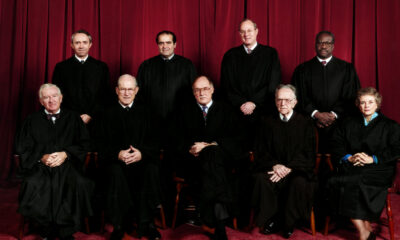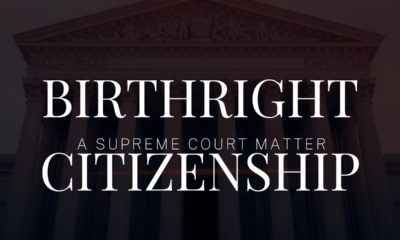Education
Discrimination in reverse to end?
The Supreme Court heard argument in two cases of reverse discrimination in university admissions. The conservatives seem ready to end it.
Yesterday the Supreme Court of the United States heard argument in two classic cases of racial discrimination in university admissions. The arguments showed plainly that the universities involved have no case at all. Their defenses amounted to “We obey orders,” said “orders” being existing Supreme Court precedents. But the argument sessions also showed the remaining ideological corruption that will plague this Court unless and until Congress finds the courage to remove members of the judiciary from the bench – on impeachment for and conviction of infidelity to the Constitution and its founding principles.
A tale of two universities
Students for Fair Admissions brought suit against two universities, alleging racial discrimination in admissions. The two universities are one each public and private university:
At first the Court consolidated those two cases. But the Court then de-consolidated them, for two reasons. First, the cases present two questions each, but present only one question in common. That question is whether Title VI of the Civil Rights Act forbids racial discrimination in univeristy admissions. In addition, UNC, as a public university system, must obey the Equal Protection Clause of the Constitution. That doesn’t apply to Harvard, which is a private university and always has been.
Second, Justice Ketanji Brown Jackson was once associated with Harvard. Therefore she must recuse, or disqualify, herself from taking any part in the Harvard case.
An earlier Court allows racial discrimination – sort of
The common question in both cases concerns the precedent of Grutter v. Bollinger, 539 U.S. 306 (2003). Barbara Grutter, white, applied for admission to University of Michigan Law School. Her white-ness knocked her out of the box. She sued—and lost. Justice Sandra Day O’Connor delivered the opinion of the court.
In a 5-4 opinion delivered by Justice Sandra Day O’Connor, the Court held that the Equal Protection Clause does not prohibit the Law School’s narrowly tailored use of race in admissions decisions to further a compelling interest in obtaining the educational benefits that flow from a diverse student body. The Court reasoned that, because the Law School conducts highly individualized review of each applicant, no acceptance or rejection is based automatically on a variable such as race and that this process ensures that all factors that may contribute to diversity are meaningfully considered alongside race. Justice O’Connor wrote, “in the context of its individualized inquiry into the possible diversity contributions of all applicants, the Law School’s race-conscious admissions program does not unduly harm nonminority applicants.”
The five were O’Connor, Stevens, Souter, Ginsburg, and Breyer JJ. The four dissenters were Rehnquist CJ and Kennedy, Scalia, and Thomas JJ.
Since then, the composition of the Court has radically changed. In place of Stevens and Ginsburg JJ we have Alito and Barrett JJ. Those two substitutions change the ideological balance of the Court. This, then, sets the background for the five hours of argument that took place yesterday (October 31).
Kagan, Sotomayor, and Jackson defend racial discrimination
Reportage on the argument day comes from The New York Times and The Daily Signal. In addition, we have the argument transcripts themselves, in the UNC and Harvard cases. (The Court also makes available downloadable sound recordings of the UNC and Harvard arguments.)
The two lawyers for petitioners Students for Fair Admissions open with a direct appeal to Brown v. Topeka Board of Education. They also point out that neither school argues that they must “make up” for any discrimination in the larger society. That’s one argument they cannot make, though Kagan, Sotomayor, and (for UNC) Jackson try to make it for them. Their bottom line: racial classifications are simply wrong on their face.
Furthermore the information available to the universities is incomplete! The application form for admission includes a checkbox question: “What is your race?” A student may answer—or not—as he wishes.
Are they telling the truth?
Also, no one checks that answer out for truthfulness later. In the UNC case, Justice Alito forced UNC’s counsel to admit that the criteria for racial identification are fearfully lax.
Q. When can a student honestly claim to fall within one of these groups that is awarded a plus factor? So let’s say the student has one grandparent who falls within that class. Can the student claim to be a member of an underrepresented minority?
A. Yes, we rely on – on self-reporting. And – and we don’t give any…
Q. All right. One great-grandparent.
A. If that person believes that that is the accurate expression of their identity, I don’t think there would be any problem.
Q. One great-great-grandparent? Are you going to make me continue to go on?
A. Right, right, right. I think that as we go on, I agree that it would seem less plausible that that person would feel that this is actually capturing my true racial identity but the same is true for any of the other diversity factors that we rely on.
Family lore
Q. It’s family lore that we have an ancestor who was an American Indian.
A. So I – I think in that particular circumstance, it would be not accurate for them to say based on…
Q. Well, I identify as an American Indian because I’ve always been told that some ancestor back in the old days was an American Indian.
A. Yes, so I think in that circumstance, it would be very unlikely that that person was telling the truth. And the same is true for – you know, we rely on self-reporting for all the – the demographic and other characteristics that we ask for. And there’s nothing special about the racial identification on that score, Your Honor.
Isn’t there? Is this not the heart of the matter? Can the legal departments at UNC or Harvard really be naïve enough to assume that applicants always tell the truth? Doesn’t the recent College Admissions Scandal tell them otherwise?
Your editor need not rely on the recent history of Operation Varsity Blues (2019). When he matriculated at Yale College in 1976, so did another student who came with glowing recommendations attesting to his academic ability and rich life experience. Before we broke for Christmas, that student was out of Yale. His entire record was fraudulent from beginning to end. The administration discovered the fraud by the oldest method available: he couldn’t do the work.
Besides, we know of one famous person who did rely on family lore to score points: Senator Elizabeth Warren (D-Mass.).
What is the point, and when does it end?
All these cases tell us that students will check off anything to try to get in. And as Alito further pointed out, college admissions is a zero-sum game. Colleges and universities have only so many “slots” available. Absolutely any institution of elementary, secondary, or higher education must limit admissions by reason of availability of space. So to make space for members of one group deserving of “social justice,” one must necessarily shove others aside.
Senator Warren earned the sobriquet “Fauxcahontas” because she lied about her Cherokee affiliation to score political points. (The Cherokee Nation has repudiated her self-identification.) Surely Jackson, Kagan, and Sotomayor JJ know this. That should tell them that racial distinctions are pointless – a point Thomas J understands.
But they do not. Worse, Justice Sotomayor definitely tried to assert a fact not in evidence, for which she laid no foundation. She argued in the Harvard case that de jure discrimination still occurred, discrimination Harvard is in honor bound to remedy. Alito and Gorsuch both called her on that.
Alito also asked: when does it end? The SFFA lawyer in the UNC case brought up, in fact, that the Grutter majority contemplated an eventual end. Both UNC and Harvard argue that they have the power to discriminate in perpetuity.
Shall reverse discrimination finally end?
Justice Jackson, in the UNC case, questioned whether the Asian students who lost out at UNC could claim any injury in fact. She reasoned that UNC (like Harvard) “looks at the whole person.” But she and her colleagues miss these points:
- Race cannot be an adequate proxy for adversity as an explanation of poor prior academic performance.
- The Constitution guarantees individual justice, not group justice.
- College admissions committees must concern themselves with predictors of academic performance. They do “members of underrepresented groups” no favors if they admit students who later flunk out. If they want to affect the larger society, they have to make sure those students graduate. (And if they fudge graduation requirements, future employers will know, and that will harm all who graduate from the institutions involved.)
The tone of the questions of the nine Justices (eight in the Harvard case) predicts that the Court will likely rule 6-3 (or 5-3 in the Harvard case) in favor of the petitioners. Decades of reverse discrimination will end. The time to ensure educational opportunity starts during childhood, to prepare the future student to do college work. This also assumes that any student would benefit from a college education; not all prospective students would. But those who would, should not face discrimination as a punishment for some real or imagined crime that, in any case, they did not commit.
Terry A. Hurlbut has been a student of politics, philosophy, and science for more than 35 years. He is a graduate of Yale College and has served as a physician-level laboratory administrator in a 250-bed community hospital. He also is a serious student of the Bible, is conversant in its two primary original languages, and has followed the creation-science movement closely since 1993.
-

 Civilization5 days ago
Civilization5 days agoOn the 2025 National Security Strategy
-

 Civilization3 days ago
Civilization3 days agoIvory Tower Thinking and Narcotics Boats
-

 Executive2 days ago
Executive2 days agoThe Last Supper: New York’s Socialist Feast
-

 Civilization2 days ago
Civilization2 days agoYoo Hoo, VP Vance—Your Character is Showing!
-

 Executive5 days ago
Executive5 days agoWaste of the Day: Shockingly, Inmate Phone Calls Lead to More Criminal Activity
-

 Civilization5 days ago
Civilization5 days agoIf Not a Musk, Then the Navy Needs Another Rickover
-

 Civilization2 days ago
Civilization2 days agoFacing Facts & Rolling Back Mythologies: The New National Security Strategy
-

 Executive4 days ago
Executive4 days agoWH Ignores Demands From Pro Life Lobby To Fire FDA Commissioner














